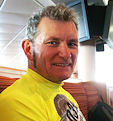Basse-Normandie has been a popular area for the Tour de France to visit. Whether the route is going clockwise towards the Alps or westerly to Brittany, it has been the home of La Grande Boucle's first week for as long as I've been following it closely.
I've seen the final day of the Tour in Paris, back in the 1980s - I took my then girlfriend on a (cough) romantic weekend and bemoaned the road closures that left us 200 agonising metres short of the entrance to the Louvre. I'm surprised we actually got a hotel room, on reflection. Actually, I'm not - it was pretty rough and in the Sacre Coeur area, up a thousand narrow stairs and overlooking a kebab shop.
Digressions aside, over the last five years we've managed to combine family holidays or short breaks to Calvados and the Mayenne to catch some of the action. My first experience of the Tour caravan and the final kilometre proper was in 2011 for Team Sky's inaugural stage win at Lisieux - I still have the bag of Haribo I snatched from a crying child's grasp (the child was already crying, by the way - my pounce for the gummi bears didn't upset him as much as the elderly French woman stamping on his hand for a polka dot cap).

I missed French action last year, acting as a Tour Keeper on the Mall - a stressful day involving much advice on how to get to Horseguards Parade and answering questions about why the road was closed - so I was determined to get back over to the continent this year. And, as luck would have it, a stage finish was announced near where my sister has retired to, at Fougeres. Possibly against my better judgement, I decided that cycling from the ferry port to hers was a spiffing idea and very doable, and my long-suffering cycle buddy, Nick, agreed.
Crossing to Le Havre was out of the question as it would be hideously busy, having secured a stage finish the day we were due to arrive, so we decided to sail to Ouistreham, the terminal just north of Caen, and cycle directly south to the Pays de la Loire.
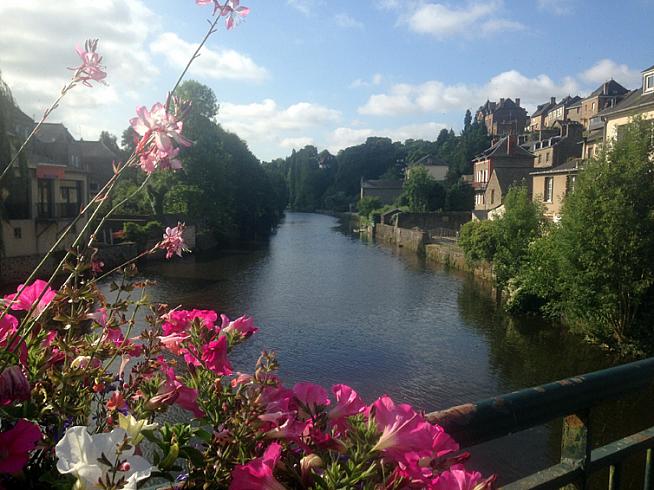
Much planning was required (as well as training to cope with the six-hour ride), but having driven the route a few times I was confident that it was straightforward and not too difficult. Tickets were booked for two overnight sailings and prep began on deciding what take. Having a road bike meant that I had no mounting points (nor desire for) panniers, so I was on the lookout for a compact and comfortable backpack that could hold all a gentleman tourist would require en vacances.
As we'd be staying at my sister's house, we could afford to take just the bare essentials and not have to resort to forwards-backwards-inside-out when it came to underwear. Likewise with cycling kit - if the gear I was wearing didn't self-destruct before I got there, then it could be laundered ready for the return journey.
All things went smoothly to start with. I got the train directly to Portsmouth (meeting Nick at a station on the way) and the ten-minute trundle to the ferry port was relatively trouble-free. Booking in was easy, and we were joined in our queue by several other cyclists heading off for a couple of days in Northern France. After a cursory customs check where we were politely asked if we were carrying any prohibited items and had our backpacks X-rayed, we were shepherded on to the ship and allowed first go at the bar, before the car and lorry drivers got on.
Lesson Learned Number 1:
When preparing for an 85-mile, early morning cycle ride with luggage, after a seven-hour ferry crossing, make sure you book yourself a cabin. DO NOT rely on a ferry company's description of 'reclining chairs' as an alternative to a proper bed.
I really do not know why they don't rip out these torture devices and replace them with cushioned flooring. If you wanted to discourage the homeless from sleeping in a shop doorway, you'd present them with one of these chairs.
So, after a night of regret at not shelling out for a cabin and having to listen to multi-lingual snoring, groaning and farting, we rolled down the exit ramp and into La Belle France. I made the faux pas of keeping my passport and my Euros together in the one pocket, much to the consternation of a border guard who may've thought I was trying to bribe my way through 'Rien à Déclarer' - luckily, my mumbled/mangled apology was intelligible enough and I got back to trying to remember which side of the road to ride on.
Lesson Learned Number 2:
Do not assume that because you've programmed a route into your Garmin, it will magically guide your clumsy effort at navigation to the correct place. We rode around Ouistreham for the best part of an hour trying to find our 'start point' and in the end just followed the road signs to Caen. This was a big mistake, as the road signs are designed as the best way to get lorries and tourists out of town and off to the city.
What we should have been looking for was the sign to the Voie Verte, 100 metres to our left, that would have taken us serenely and safely right into the centre of Caen along a wide, smooth cycle path - rather than a bustling, noisy and downright terrifying A road which, although smooth, was littered with large pieces of debris and stones.
Still - we had GPS-enabled phones, a smattering of local language and the determination to keep going south. Once through the city of Caen itself, the roads calmed down and we settled into a routine of riding for a while, stopping to check position and then carrying on, until we reached the first stop of the day, Thury-Harcourt, a town I remembered from my various car journeys.
The good thing about the roadside café/bar in France is that they're happy to serve cyclists, fill up water bottles and let you eat stuff you've brought with you, or bought from the local patisserie. It was quite a relief to hit a major town, as we had progressed this far purely by luck and calculated guesses. Now I knew where we were going, I felt much happier.
Happier that is, until we hit the region known as Suisse-Normande. I'd only ever heard about this area from the brown info signs on the Péage between Le Havre and Caen, but as we passed the regional capital at Clécy, the road just pitched up and we trundled for several kilometres at an average of 7%. If you ever want to know what it's like to do an Alpine climb while being passed by massive farm machinery and caravans, then Suisse-Normande is the place to come.
No hairpins, no scenic valleys, no quaint fountains in village squares - just endless straight, undulating roads. Every settlement on the road seemed to be down a shallow descent, peppered with traffic lights and pedestrian crossings, with an evil ramp to the south side. There must also have been a rule in Normandy about hills being of a gradient of 6-8%, with no plateaus for cyclists to recover on. Over the course of the last sixty kilometres of our day, we did the majority of the 1500 metres of climbing, stopping only for the briefest of lunches (and a well deserved beer) just outside the city of Flers.
When we got to the medieval, crenelated city of Domfront, the worst of the climbing was done - but by then, being loaded with non-essentials like his iPad and a teach yourself Swahili book, Nick was beginning to suffer from the heat, the weight and the pain in his knee. We trundled the remaining 25km with a brief sortie along the route of Stage 7 between Gorron and Herce.
The Tour was due through the town next day and, having previously experienced the French and their preparations for the race, it seemed foolhardy to plan any venturing out so we resorted to anaesthetising our bodies with cider and sleep and would walk down to the village to watch the show the following afternoon.
It was my first, first-hand experience of small-town France preparing for a big event. It's a very important time - Le Tour is the biggest annual sporting event on the planet (and it's free to watch), and the coverage that French TV sells also sells France as a country. Tourists flock to the area and spend millions of Euros. We've all seen the helicopter shots of chateaus, river valleys, monuments, mountains, architecture - every town on, or close to, the route treats it as a carnival, with schools and businesses closed for the day and roads impassable.
Herce was no different, despite being a tiny village straddling the main road 30km from the finish at Fougeres. The bunting was abundant, walls and railings were dripping with brightly painted bicycles of all shapes and sizes, and there was even an enormous hay bale sculpture at the top of the village to entice the media and the world of cycling to take notice.
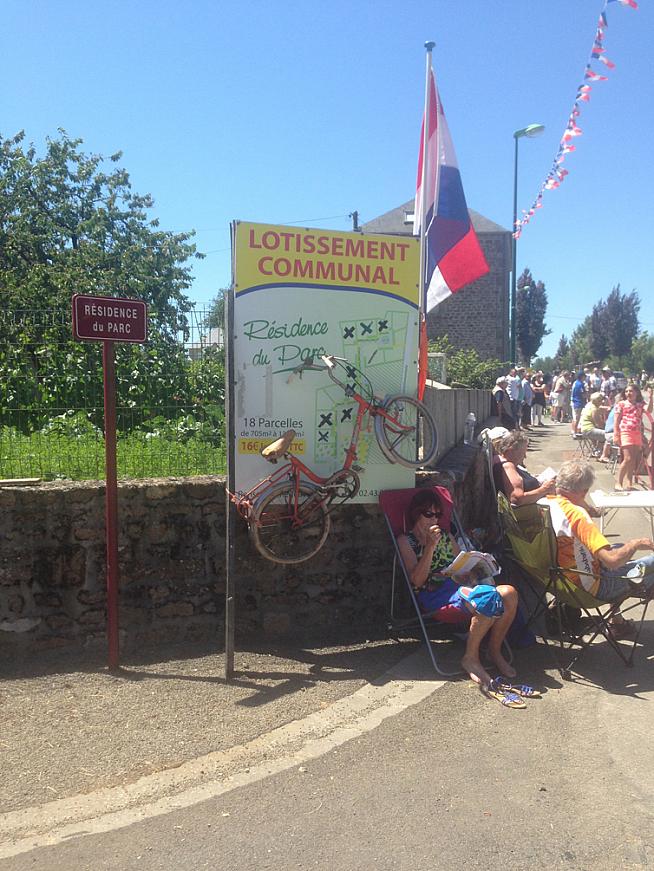
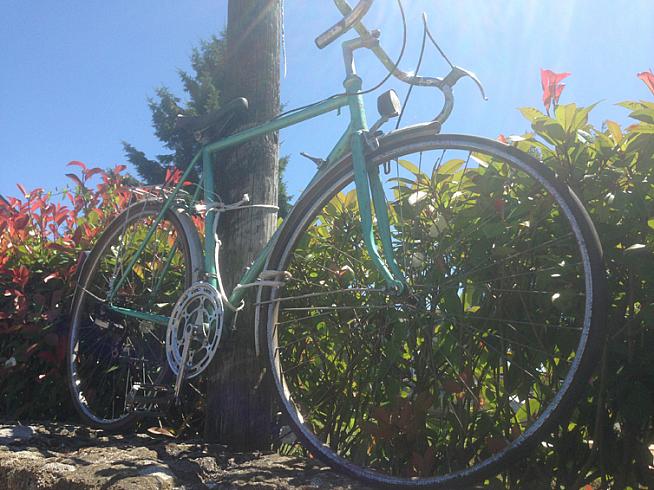
But before the arrival of the peloton comes the caravan. It's a procession of sponsors' floats and mobile stores selling and giving away armfuls of trinkets and souvenirs. And the crowd love it. There were even some that packed up and moved out after the procession of fibreglass chickens, baguettes, dogs, jelly animals, animated tyres and sundry cartoon-headed people in safety harnesses had sped through.
The cacophony of noise is hard to describe (and this on a road where the crowds were only two deep at most - on the Mall in 2014, they were 10-deep). Hats, bags of sweets, keyrings, stickers and other potential landfill was expertly jettisoned from the sponsored trucks, the most popular of which was a Vittel float that was misting the cheering roadside with water in the 25-degree heat.
What is also hard to describe is the enthusiasm and ferocity with which spectators grab for this freebie fest, but it's not usually for themselves as there is quite often a gleefully chuckling child receiving armfuls of booty like a pirate captain.
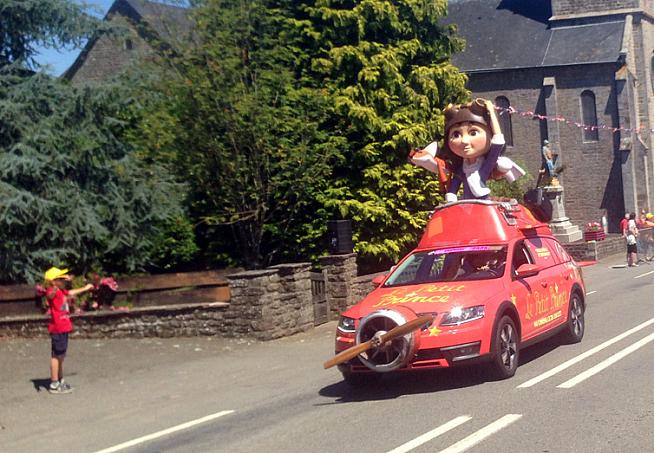

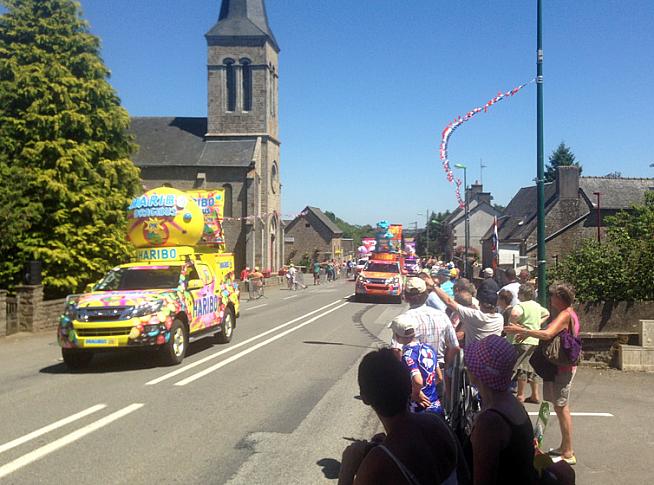

And then it's gone - a silence descends once more and we await the heralds of the approaching spectacle.
First it's the thocking of helicopters, circling above the head of the race. Then the advance outriders from the gendarmerie and the press corps, officials' cars, neutral support vehicles, the odd team or VIP car. Then, if one still exists, a breakaway of riders struggling to stay ahead of the amorphous blob of the rapidly approaching main peloton.
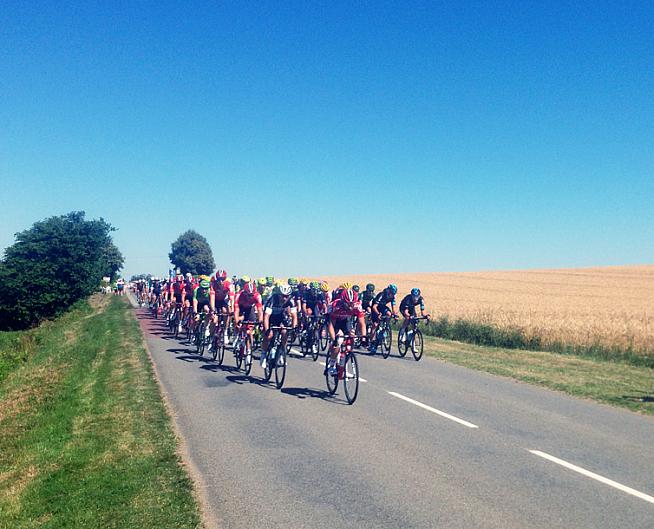
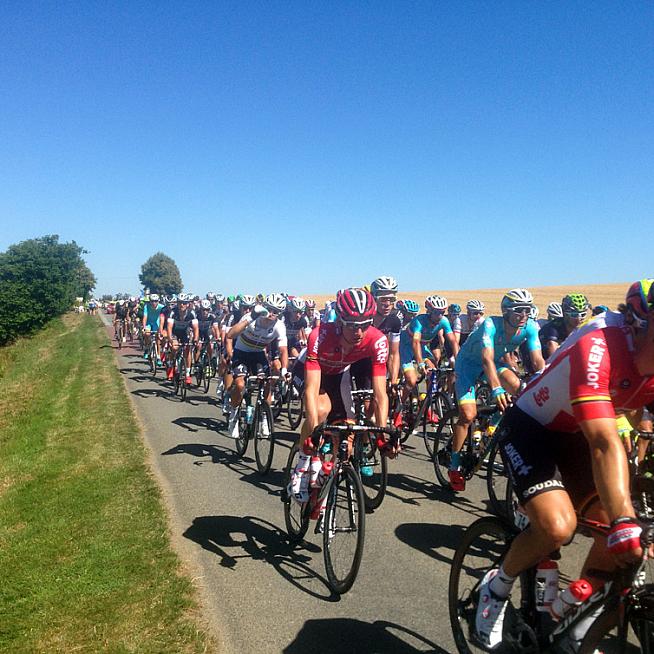
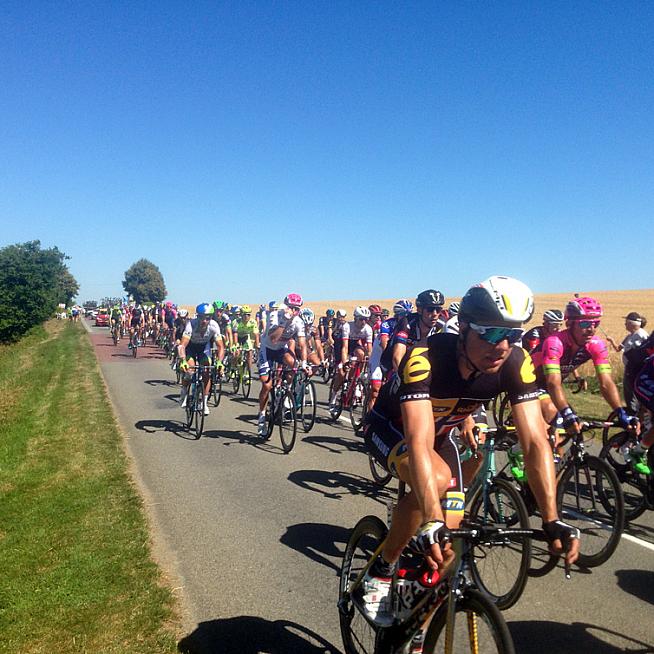
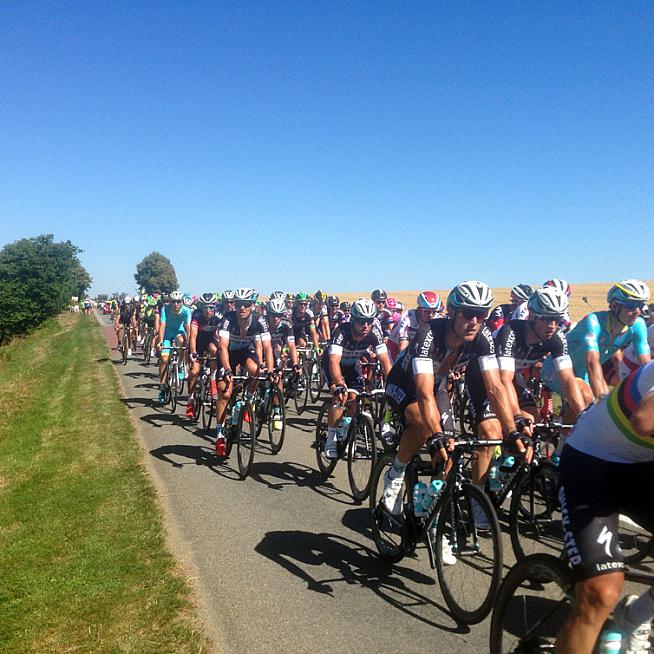
Less than a minute later, it's all over and the silence blows through once more dragging with it any stray copies of l'Equipe and sweet wrappers, a storm blowing away into the distance.
No one is disappointed - this is what they came to see. A glimpse of the maillot jaune, a discarded bidon from your favourite team or rider, a blurry photograph of last year's winner, a brief appearance on TV, waving like a madman (a pair of bright orange shoes helps to pick you out from the recorded highlights).

Later on that evening, we watched the live feed we had recorded earlier and relived that brief thirty seconds of fame, cruelly truncated by an ad-break or the camera lingering on the town statue instead of the massive hay bale bicycle with the village name on it.
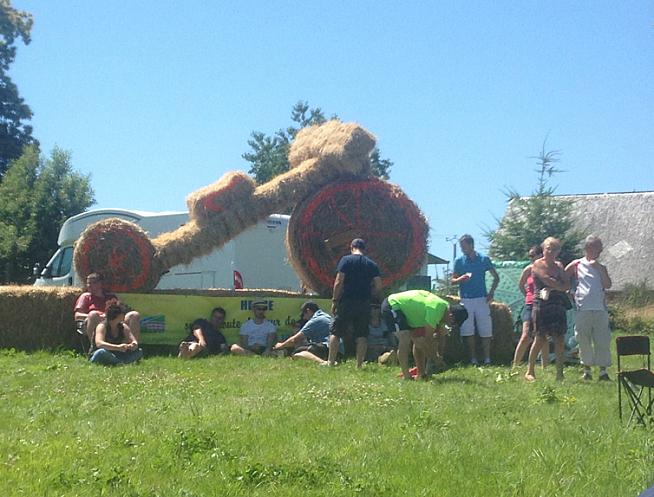
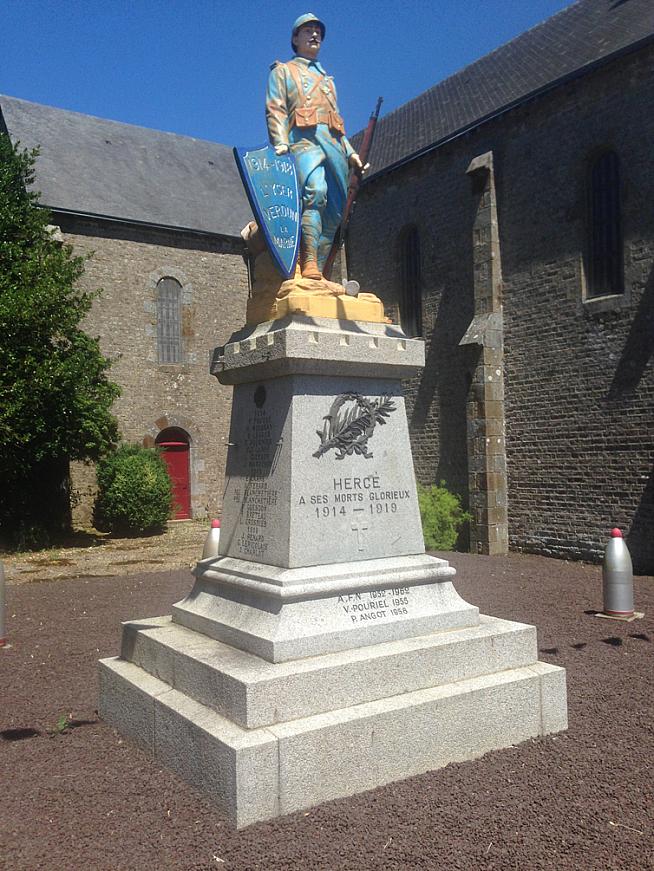
We cycled out the following morning along some of the route and the decorations were still up, although there was an eerie silence about the place, like eveyone's excitement and fun had been concentrated into one day. At Ambrières-les-Vallées we stopped to chat to some locals who had enjoyed themselves immensely, and were sublimely proud that their five-metre-high bicycle made it on to the coverage. Not so happy were the English couple who didn't realise the Tour was on, and had taken four hours to get from one side of the valley to the other because of the road closures.
Cycling away from the Tour route we headed for a local climb to test the legs and were joyfully cheered up its 20% of nastiness by people who came out into the street when they saw us, "Allez, allez, allez" ringing in our ears as we crested the top and then went in search of an open patisserie to reward our efforts.
Sadly, all too soon it was time to pack up and head for home. We arranged to leave some bulkier items at my sister's house, and grateful for the lightened load set off next day, allowing for a leisurely return to Caen. The rolling hills seemed much kinder on the way back and after a brief coffee stop in Flers, we made it back to Suisse-Normandie in time for lunch in the centre of Clecy. Here we saw our first rain for days and thought we might be in for a soaking for the remaining 50km, but it amounted to little more than a smattering.
At Thury-Harcourt we followed the main road, rather than retracing the route taken a few days previously, and found entering Caen much simpler than leaving it, a kind of reverse River Styx. Once in the centre of the city it was ludicrously easy to find the Voie Verte cycle track to Ouistreham - for 15 gloriously flat kilometres it follows the canal out to the ferry port. After a brief beer stop at the historic Pegasus Bridge, we rolled into Ouistreham with enough time to get a pizza and queue up at the front of the line to board the overnight sailing to Portsmouth.
Luckily for us (and anyone standing near us) we'd secured a cabin for the return journey so a shower and a horizontal bed awaited. Quite the best way to end a day involving a steamy seven-hour ride. Nothing to report during the sail back as I took the time to reacquaint myself with the inside of my eyelids. All we had to do was complete the simple task of boarding a train at Portsmouth and heading home. We didn't reckon on the appalling signage outside and the awful, confusing cycle paths - so bad was it, that we took 30 minutes to find the wrong railway station and missed the first train home.
Still, silver linings and that - we had time for a bacon butty...
A brief note on kit
I was mindful that I could only take a small selection of gear with me and chose with care. I was expecting hot and humid weather, up to 27 degrees centigrade, so I was using a Technical Cycle Jersey from Meccanica and my favourite Planet X 365 bib shorts - don't panic, I took other clothes and shoes as well.
The Meccanica was a sound choice. Decribed as 'race fit' (something which I'm evidently not) I went a size higher than recommended and it fit beautifully. Combined with a lightweight mesh base layer, it regulated my temperature fantastically (even with a 7 kilo backpack) and stayed in place, thanks to the long back and excellent silicon grippers on the hem.
The jersey has a half zip at the front but it's beautifully concealed - I couldn't actually work out where it stopped until I tried to undo it further than it would go. There are three generous pockets on the back, plus a zippered smaller compartment for valuables. This comes in handy if you have shrapnel left over from numerous cake stops. I love the bold retro styling too, and it always helps to have a modest Union Jack on your shirt to let café owners know your French is going to be enthusiastic if not accurate.
Lastly, a few words about my luggage. I picked up an Osprey Syncro 15 rucksack from Wiggle. It has many zippered compartments, a built-in high-visibility rain cover, AirSpeed suspension, and a ventilated harness which kept the bulk off my back and helped me remain cool. You can secure your helmet to it when not in use with a clever toggle/bungee system and also buy a hydration bladder to fit inside. There are handy internal pockets for pumps (the inflation kind, not shoes) and a clip for my keys. A smaller, reinforced pocket between the main two compartments was the ideal size to store my phone, passport and emergency charger as well.
1 Comments

